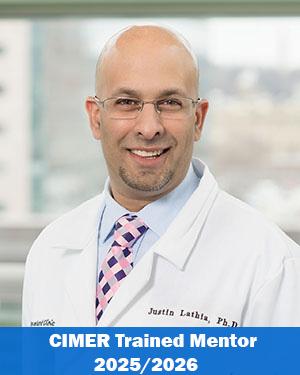Research News
05/01/2020
Defining Sex-Based Differences in Glioblastoma Biology
Dr. Lathia found that the subpopulations of myeloid-derived suppressor cells differ significantly between males and females with the aggressive brain cancer, and that they each contribute to disease pathology differently.

New research from the lab of Justin Lathia, PhD, Department of Cardiovascular & Metabolic Sciences, points to a possible biological explanation behind why men are more likely than women to develop glioblastoma (GBM) and why their cases are usually more aggressive and carry a poorer prognosis. The answer—or at least part of it, he believes—lies in sex-based differences in immunosuppression.
Myeloid-derived suppressor cells (MDSCs) are a type of immune cell that Dr. Lathia previously showed are elevated in GBM patients compared to those without the highly lethal brain cancer. Based on their known role in helping tumor cells escape immune response, researchers believe they importantly contribute to the aggressive and often treatment resistant nature of GBM.
While immunotherapy treatment approaches have had success in treating some preclinical models and patients with solid tumor cancers, they have yet to show signs of success in the context of GBM. This is believed to be due in part to MDSCs as they prevent activated immune cells from functioning properly.
MDSC subpopulations broken down by sex
Published ahead of print in Cancer Discovery, the lab’s latest study shows that MDSC subpopulations differ significantly in GBM in a sex-specific manner. Male GBM models, they found, had elevated levels in the tumor microenvironment of the monocytic MDSC subset (mMDSCs), while female models had elevated levels circulating in the blood of the granylocytic MDSC subset (gMDSCs).
Curious to know the functional effects of these cell subtypes, the researchers conducted expression analyses. Proteins known to be involved in cell proliferation pathways were upregulated in mMDSCs and molecules that are involved in regulating immune response were upregulated in gMDSCs.
If mMDSCs, which support overactive cell proliferation, are more abundant in men with GBM, this could lead to an unchecked spread of cancer cells and possibly explain why the disease is disproportionately aggressive in male patients, the team posited.
A rationale for treating GBM differently in males versus females
“Appropriate treatment approaches must match what is happening within a patient’s body,” said Dr. Lathia, who co-leads the Center of Excellence in Brain Tumor Research and Therapeutic Development. “Considering that glioblastoma manifests differently and with different frequency in men versus woman—and now that we know even the immune system and the functions of some immune cells differ by sex in glioblastoma—we have new insights into what those ‘appropriate treatment approaches’ may be.”
Continuing their work in preclinical GBM models, the team administered two different treatments to male and female models, ones which target mMDSCs and gMDSCs, respectively, and their related functions.
They found that in male models, the chemotherapy drug fludarabine (which was identified as a promising drug candidate by analyzing known drug-target interactions), had positive effects on slowing disease progression, and that a cytokine-blocking agent (an interleukin-1 pathway inhibitor) helped inhibit gMDSCs’ pro-disease characteristics, specifically in females.
While additional research will be necessary, these early findings suggest that mMDSCs may be central to why males with GBM fare worse than their female counterparts. The study’s elucidation of how each of the MDSC subtypes contributes to pro-disease processes in men versus women will provide a critical foundation of knowledge as research into precision GBM treatments advances, ones which importantly take into consideration the sex bias in disease biology.
Defne Bayik, PhD, a postdoctoral fellow in the Lathia lab, was first author on the study, which was supported in part by the National Institute of Neurological Disorders and Stroke, the National Cancer Institute, the Sontag Foundation and the American Brain Tumor Association.
Featured Experts
News Category
Related News
Research areas
Want To Support Ground-Breaking Research at Cleveland Clinic?
Discover how you can help Cleveland Clinic save lives and continue to lead the transformation of healthcare.
Give to Cleveland Clinic